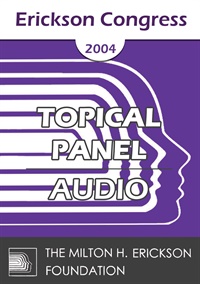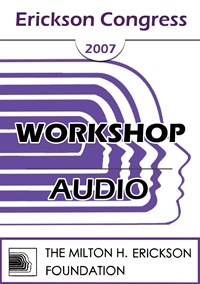
- Average Rating:
- Not yet rated
- Topic Areas:
- Short Courses | Milton Erickson
- Categories:
- Erickson Congress 2001 | Erickson Congress
- Faculty:
- Liliana Cane, PhD
- Duration:
- 1:14:39
- Format:
- Audio Only
- Original Program Date:
- Dec 06, 2001
- Short Description:
- IC01 Short Course 23 - Working with Creativity: Milton H. Erickson's Ecology of Inner Resources - Liliana Cane, PhD Milton H. Erickson, who endowed psychotherapy with an attitude of openness and creativity, conceptualized symptoms as an access way towards unconscious creative resources. Listening to the client's symptoms with an open and creative attitude can lead to a transformational dialogue that modifies the ecology of inner resources. Deep and long-term healing are activated in short-term interventions.
- Price:
- $15.00 - Base Price
- Average Rating:
- Not yet rated
- Topic Areas:
- Fundamentals of Hypnosis | Ericksonian Hypnosis and Therapy Techniques | Milton Erickson | Hypnosis | Resources
- Categories:
- Erickson Congress | Erickson Congress 2004
- Faculty:
- Michael Yapko, PhD
- Duration:
- 2:15:23
- Format:
- Audio Only
- Original Program Date:
- Dec 05, 2004
- Short Description:
- Milton Erickson's approach typically featured finding hidden personal resources and extending them into situations where they would help the client. We will first see a portion of this basic, but valuable, strategy in a video of Dr. Erickson; then have the opportunity to practice this strategy in a structured practice session.
- Price:
- $15.00 - Base Price

- Average Rating:
- Not yet rated
- Topic Areas:
- Keynotes | Meditation, Spirituality and Yoga | Milton Erickson | Psychotherapy | Therapist Development | Social Issues
- Categories:
- Erickson Congress | Erickson Congress 2004
- Faculty:
- Cloe Madanes, HDL, LIC
- Duration:
- 53:36
- Format:
- Audio Only
- Original Program Date:
- Dec 02, 2004
- Short Description:
- From Freud to Erickson to the current practice of psychotherapy, the nature of human problems has remained the same. What has changed is which problems we consider are within the realm of psychotherapy to elucidate. When Erickson introduced the concept of directive therapy, the field changed, not only in terms of how to do therapy, but also in terms of what are the issues a therapist must address. Is there a place for the concept of evil, for the practice of justice, and for the spiritual realm in therapy? What do we know today that we didn't know a hundred years ago? How can we preserve the existence of the therapist as humanist, social activist and systemic thinker?
- Price:
- $15.00 - Base Price

- Average Rating:
- Not yet rated
- Topic Areas:
- Live Sessions | Milton Erickson | Special Topics
- Categories:
- Erickson Congress | Erickson Congress 2004
- Faculty:
- Rubin Battino, MS
- Duration:
- 58:06
- Format:
- Audio Only
- Original Program Date:
- Dec 03, 2004
- Short Description:
- IC04 Live Session 01 - THAT'S RIGHT, ISN'T IT? A Play About the Life of Milton H. Erickson, M.D. - Rubin Battino, M.S.
- Price:
- $15.00 - Base Price
Tags: Milton Erickson

- Average Rating:
- Not yet rated
- Topic Areas:
- Workshops | Milton Erickson | Therapist Development
- Categories:
- Erickson Congress | Erickson Congress 2004
- Faculty:
- Dan Short, PhD
- Duration:
- 1:12:45
- Format:
- Audio Only
- Original Program Date:
- Dec 01, 2004
- Short Description:
- The influence of Milton H. Erickson, M.D. can now be seen around the globe. The strength of the Erickson movement, the proliferation of Ericksonian Institutes, and the millions of lives that have been transformed are the product of dedication and leadership. By reviewing the actions of Erickson and those who followed, we become better oriented to new possibilities. The call to leadership is for any who wish to make a difference in this world.
- Price:
- $15.00 - Base Price

- Average Rating:
- Not yet rated
- Topic Areas:
- Topical Panels | Milton Erickson
- Categories:
- Erickson Congress | Erickson Congress 2004
- Faculty:
- Betty Alice Erickson, MS, LPC, LMFT | Stephen Lankton, MSW | Dan Short, PhD | Jeffrey Zeig, PhD
- Duration:
- 58:35
- Format:
- Audio Only
- Original Program Date:
- Dec 03, 2004
- Short Description:
- IC04 Topical Panel 06 - About Milton H. Erickson, MD - Betty Alice Erickson, M.S., Stephen Lankton, M.S.W., Dan Short, Ph.D., Jeffrey Zeig, Ph.D.
- Price:
- $15.00 - Base Price

- Average Rating:
- Not yet rated
- Topic Areas:
- Dialogues | Milton Erickson
- Categories:
- Erickson Congress | Erickson Congress 2007
- Faculty:
- Marilia Baker, MSW | Dan Short, PhD | Alexander Simpkins, PhD | Annellen M. Simpkins, PhD
- Duration:
- 57:57
- Format:
- Audio Only
- Original Program Date:
- Dec 08, 2007
- Short Description:
- IC07 Dialogue 07 - All Things Erickson - Marilia Baker, MSW, Dan Short, Ph.D., Alexander Simpkins, Ph.D. and Annellen Simpkins, Ph.D.
- Price:
- $15.00 - Base Price

- Average Rating:
- Not yet rated
- Topic Areas:
- Topical Panels | Milton Erickson
- Categories:
- Erickson Congress | Erickson Congress 2007
- Faculty:
- Betty Alice Erickson, MS, LPC, LMFT | Stephen Gilligan, PhD | Stephen Lankton, MSW | Ernest Rossi, PhD
- Duration:
- 1:02:11
- Format:
- Audio Only
- Original Program Date:
- Dec 08, 2007
- Short Description:
- IC07 Topical Panel 11 - About Milton H. Erickson, MD - Betty Alice Erickson, M.S., Stephen Gilligan, Ph.D., Stephen Lankton, M.S.W., Ernest Rossi, Ph.D.
- Price:
- $15.00 - Base Price

- Average Rating:
- Not yet rated
- Topic Areas:
- Workshops | Self-Hypnosis | Ericksonian Hypnosis and Therapy Techniques | Milton Erickson | Hypnosis
- Categories:
- Erickson Congress | Erickson Congress 2007
- Faculty:
- Sidney Rosen, MD
- Duration:
- 1:15:07
- Format:
- Audio Only
- Original Program Date:
- Dec 07, 2007
- Short Description:
- Waking Hypnosis was first described by Wells in 1924. Dr. Rosen will give examples of Milton Erickson having used it in his seminars. Participants will explore ways of maximizing their response to autosuggestions and then there will be discussion and practice of potential applications in everyday life.
- Price:
- $15.00 - Base Price

- Average Rating:
- Not yet rated
- Topic Areas:
- Workshops | Ericksonian Hypnosis and Therapy Techniques | Metaphors | Milton Erickson
- Categories:
- Erickson Congress | Erickson Congress 2007
- Faculty:
- Norma Barretta, PhD | Phillip Barretta, MA, MFT
- Duration:
- 1:31:09
- Format:
- Audio Only
- Original Program Date:
- Dec 09, 2007
- Short Description:
- Giulia’s story began almost 30 years ago while Milton Erickson was still with us. He offered amusingly bizarre suggestions to us about what to do with her. Those suggestions lead to several metaphors which helped her to create an escape plan from the “zoo” in which she was trapped.
- Price:
- $15.00 - Base Price
Please wait ...


